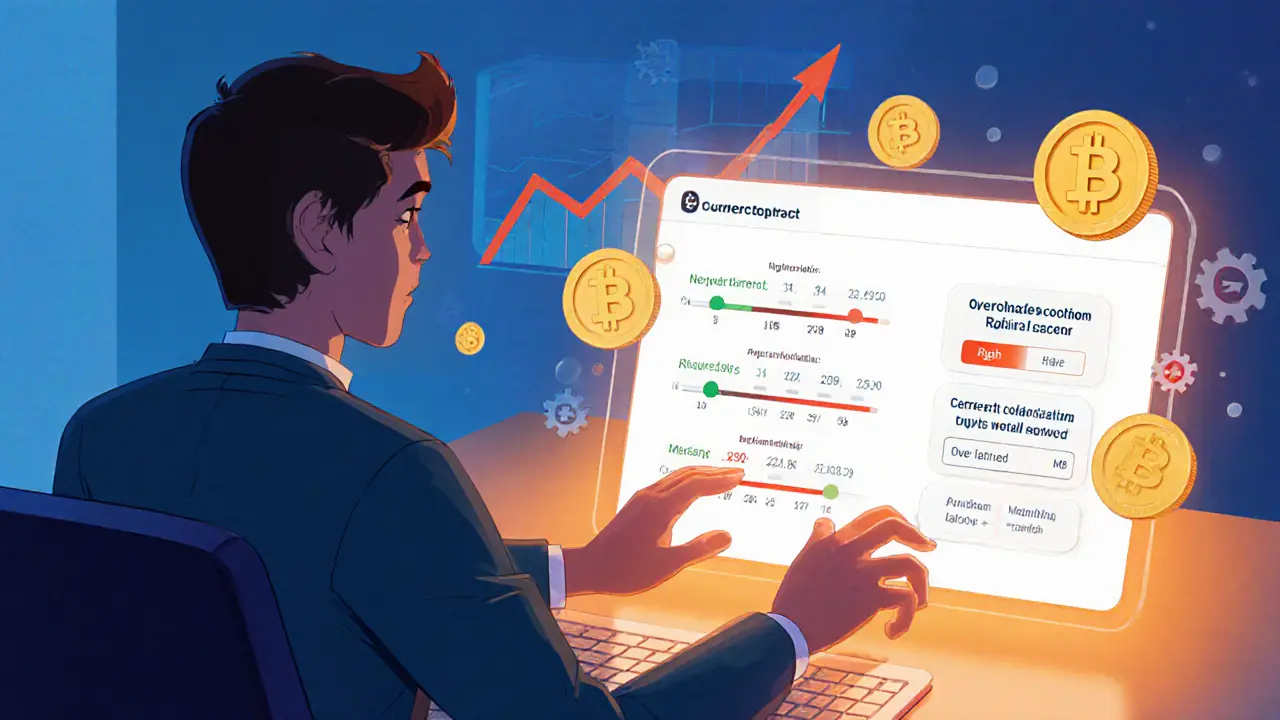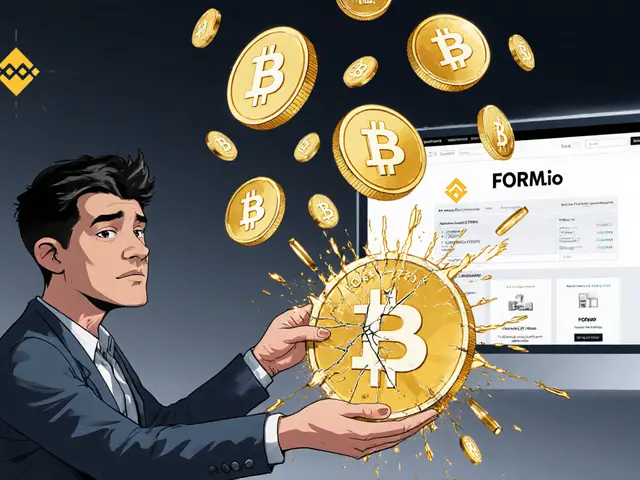Crypto-Backed Stablecoin Calculator
Calculation Results
Collateral Required: $0.00
Stablecoins Issued: $0.00
Current Collateral Ratio: 0%
Risk Level: -
Liquidation Threshold: -
Recommended Action: -
Key Takeaways
- Crypto-backed stablecoins keep a stable value by locking more crypto assets than the coins they issue.
- Overcollateralization ratios typically sit between 150% and 200% to guard against market swings.
- Smart contracts automate liquidation, but rapid price drops can still trigger cascade effects.
- Compared with fiat‑backed stablecoins, they offer decentralization at the cost of capital efficiency.
- 2025 sees $140billion in total stablecoin supply, with crypto‑backed variants growing as DeFi matures.
Crypto-backed stablecoins is a decentralized digital currency that maintains a stable value by overcollateralizing with other crypto assets such as Ethereum or wrapped Bitcoin. Instead of a bank holding dollars, the protocol itself holds crypto, and smart contracts enforce the rules.
For readers looking to understand the basics, we’ll walk through the mechanics, compare them to fiat‑backed peers, flag the biggest risks, and highlight what 2025 market data tells us about adoption.
How Crypto‑Backed Stablecoins Work
- Choose a collateral asset - most platforms accept Ethereum (ETH) or wrapped Bitcoin (wBTC).
- Deposit the collateral into a smart contract. The protocol requires an overcollateralization ratio of roughly 150%-200%.
- Mint stablecoins equal to a fraction of the deposited value. For example, deposit $150 worth of ETH to receive $100 worth of a stablecoin.
- The smart contract continuously monitors the market price of the collateral.
- If the collateral value slides toward the liquidation threshold, the contract either sells part of the collateral automatically or prompts the user to add more.
- When the user wants to redeem, they return the stablecoins and reclaim their collateral (minus any liquidation penalties).
The automated nature of these steps eliminates the need for a central custodian, but it also means the system relies heavily on accurate price oracles and robust contract code.
Comparison with Fiat‑Backed Stablecoins
| Aspect | Crypto‑Backed | Fiat‑Backed |
|---|---|---|
| Backing Asset | Cryptocurrencies (e.g., ETH, wBTC) | U.S. dollars held in bank accounts |
| Collateral Ratio | 150%-200% (overcollateralized) | 100% (1:1) |
| Governance | Decentralized protocol, smart contracts | Central entity (e.g., Tether Ltd., Circle) |
| Transparency | Public blockchain data, on‑chain verification | Audited reserves, but off‑chain |
| Capital Efficiency | Low (requires excess collateral) | High (direct fiat backing) |
| Key Risks | Collateral volatility, smart‑contract bugs, liquidation cascades | Regulatory scrutiny, reserve misreporting |
| Examples | DAI, sUSD | USDT, USDC |

Key Risks and How They’re Managed
While decentralization removes a single point of failure, it introduces new failure modes.
- Collateral volatility: Fast‑moving crypto prices can erode the safety buffer. Protocols mitigate this by setting high collateral ratios and using multiple asset types.
- Smart‑contract vulnerabilities: Bugs can be exploited to steal collateral. Audits, formal verification, and bug‑bounty programs are industry standards.
- Liquidation cascades: If many users hit the threshold simultaneously, the system may need to sell large amounts of collateral quickly, driving prices down further. Some platforms use auction mechanisms to smooth price impact.
- Oracle attacks: Price feeds could be manipulated. Reputable decentralized oracles (e.g., Chainlink) provide redundancy and consensus.
Experts at J.P. Morgan warn that “run risks” remain a concern, citing the TerraUSD collapse of May2022 as a cautionary tale-even though Terra was algorithmic, the dynamics are similar.
2025 Market Landscape
According to McKinsey, the total stablecoin supply topped $140billion in Q32025, with crypto‑backed variants accounting for roughly 20% of that volume. Daily transaction volume sits at $30billion, a fraction of global money flows, but growth is accelerating as DeFi protocols demand on‑chain liquidity.
Key adoption drivers include:
- Cross‑border remittances that benefit from 24/7 settlement and low fees.
- Trading desks that need fast, non‑custodial hedge instruments.
- Treasury teams using stablecoins for cash management without converting to fiat.
Regulators worldwide are still shaping rules. While some jurisdictions treat crypto‑backed stablecoins as securities, others view them as commodity tokens, creating a patchwork of compliance obligations.
Future Outlook and Adoption Strategies
For crypto‑backed stablecoins to capture a larger share of the payments ecosystem, three things must improve:
- Capital efficiency: Research into multi‑collateral pools and dynamic risk models aims to reduce the over‑collateralization requirement.
- Scalability: Layer‑2 solutions (e.g., Optimism, Arbitrum) lower transaction costs, making frequent mint‑redeem cycles cheap.
- User confidence: Transparent dashboards showing real‑time collateral ratios and immutable audit trails build trust.
When these hurdles are cleared, crypto‑backed stablecoins could become the default bridge between traditional finance and DeFi, allowing users to hold a stable digital asset without ever trusting a centralized custodian.
Frequently Asked Questions
What is the main difference between crypto‑backed and fiat‑backed stablecoins?
Crypto‑backed stablecoins use other cryptocurrencies as collateral and rely on smart contracts for stability, while fiat‑backed stablecoins hold actual dollars or other fiat currencies in bank accounts, managed by a central entity.
How does overcollateralization protect the stablecoin’s peg?
By requiring users to lock more value than the stablecoins they receive (e.g., $150 worth of ETH for $100 of stablecoins), the protocol creates a buffer that absorbs price drops in the underlying crypto without breaking the 1:1 peg.
What happens during a liquidation event?
If collateral value falls below the safety threshold, the smart contract automatically sells a portion of the collateral on‑chain to restore the required ratio. Users can avoid liquidation by adding more collateral or redeeming their stablecoins early.
Are crypto‑backed stablecoins safe from hacks?
Safety depends on contract code quality and oracle reliability. Leading protocols undergo multiple audits and offer bug‑bounty programs, but no system is 100% immune to exploits.
Can I use crypto‑backed stablecoins for everyday purchases?
Increasingly yes. Merchants that accept crypto payments often integrate stablecoin gateways, allowing customers to pay with a stable value token that settles instantly on the blockchain.












People Comments
Don't be fooled by the glossy UI; these crypto‑backed stablecoins are a Trojan horse for the deep‑state's surveillance agenda. The over‑collateralization ratios are just a smokescreen to keep you believing you have a safety buffer 😊. Every time you lock ETH, you're feeding an ecosystem that can be weaponized against you in a market crash. The smart contracts might be immutable, but the code is still vulnerable to hidden backdoors.
Great overview! To add a practical tip, always check the liquidation penalty on the protocol before you mint – it can vary from 5% to 15% depending on the platform. Using a diversified collateral basket, like a mix of ETH and wBTC, can mitigate volatility spikes. Keep an eye on the price oracle you trust; Chainlink feeds are widely regarded as reliable, but no oracle is infallible. Finally, consider the gas costs on layer‑2 solutions to preserve capital efficiency when you rebalance.
When we step back, the very notion of a stablecoin challenges our traditional view of money as a social contract rather than pure code. The over‑collateralization requirement forces users to lock capital that could otherwise be productive, raising interesting questions about the true cost of decentralization. It's a trade‑off between trustlessness and capital efficiency that each participant must weigh.
The pursuit of profit shouldn't blind us to the ethical implications of locking away real assets for speculative tokens. By minting stablecoins backed by volatile crypto, we're essentially gambling with others' savings, especially when retail investors lack the technical know‑how to assess liquidation risks. Transparency is touted, yet many platforms hide their oracle configurations behind proprietary layers. This is a moral gray area that deserves more scrutiny.
Look, the whole hype around crypto‑backed stablecoins is just another fad for the uninformed masses. The so‑called "decentralized" systems still rely on centralized price feeds, and the over‑collateralization factor is a gimmick to make you feel safe while you actually lose liquidity. If you really want stability, stick to fiat‑backed options and quit chasing these exotic experiments.
Enough with the moralizing – this is just another crypto circus.
While I agree that some projects can be overhyped, it's worth noting that the underlying technology does provide a unique solution for on‑chain liquidity without relying on traditional banks. The risk is real, especially if the oracle is compromised, but several protocols have introduced multi‑oracle setups that significantly reduce that vulnerability. It's a matter of doing due diligence rather than dismissing the entire concept outright.
The rise of crypto‑backed stablecoins represents a fascinating intersection of finance and technology that deserves deep appreciation.
By requiring users to lock more value than they mint, these systems create a safety buffer that, in theory, protects the peg.
However, that same buffer comes at the cost of capital efficiency, meaning that a significant amount of crypto sits idle.
For newcomers, understanding the liquidation mechanics is essential because a sudden price drop can trigger forced sales.
Smart contracts handle these events automatically, but the underlying code must be flawless to avoid exploits.
Audits from reputable firms and bug‑bounty programs add layers of confidence, though no system is perfectly secure.
The choice of collateral is also crucial; diversified baskets can smooth out volatility compared to single‑asset collateral.
Layer‑2 solutions such as Optimism and Arbitrum dramatically reduce gas fees, making frequent mint‑redeem cycles viable for everyday users.
Real‑world use cases are emerging, from cross‑border remittances to DeFi lending platforms that prefer stablecoins for collateral.
Yet regulators remain wary, with some jurisdictions classifying these tokens as securities and others as commodities.
This regulatory uncertainty can affect adoption, as institutions may hesitate to integrate assets that lack clear legal status.
Market data from 2025 shows that crypto‑backed stablecoins account for about 20% of the total stablecoin supply, a figure that is steadily climbing.
The growth is driven by the desire for trustless, on‑chain stability without surrendering custody to centralized entities.
To foster wider acceptance, projects must prioritize transparency, such as publishing real‑time collateral ratios and audit trails.
In summary, while challenges persist, the potential for crypto‑backed stablecoins to bridge traditional finance and decentralized ecosystems is immense and worth watching closely.